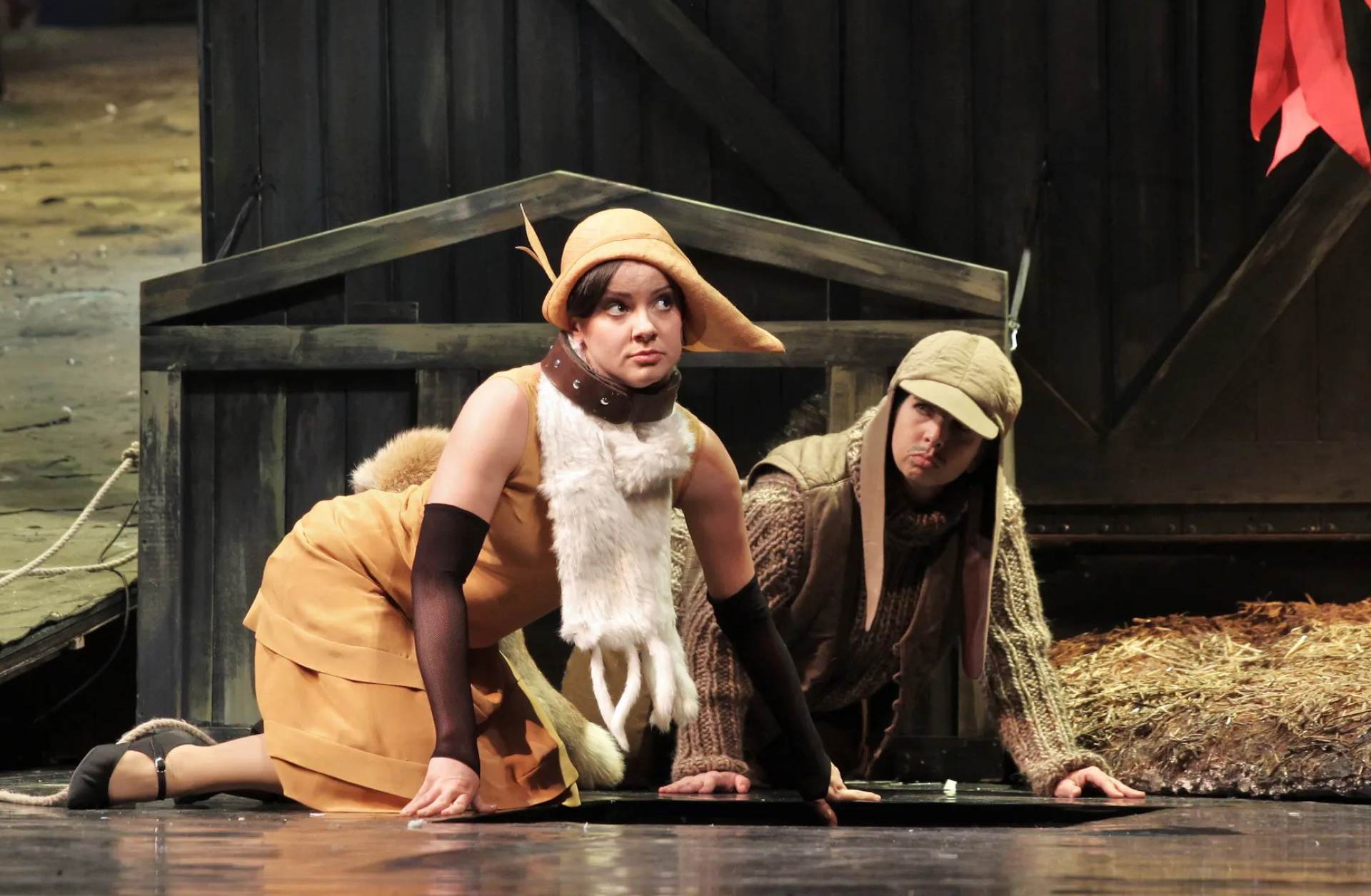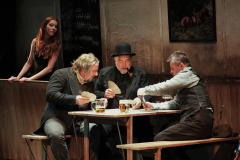The Cunning Little Vixen
Mo | Tu | We | Th | Fr | Sa | Su |
Approximate running time: 2 hours and 10 minutes, with 1 intermission (20 minutes)
Language: In Czech, surtitles in Czech, English
In The Cunning Little Vixen, Leoš Janáček, almost 70 years of age at the time, gave vent to his love for ever-regenerating Nature, of which human and animal individuals alike are merely temporary, yet wonderful and precious, parts. The opera teems with playfulness, humour, wildness, love, sorrow, wisdom – simply full-blooded life. Janáček found the original subject for the piece in Rudolf Těsnohlídek’s newspaper serial story, inspired by Stanislav Lolek’s caricature drawings. Putting foxes, a gnat, a frog, hens and other animals on the opera stage was unprecedented and highly audacious at the time – yet in retrospect not so surprising given that Janáček was an artist for ever provoking and experimenting ...
Today The Cunning Little Vixen ranks among the most feted and most frequently staged Czech operas worldwide. With its story being by turn merry and sad, it is a title possessing significant potential to captivate the audience, and owing to its wit, profound ideas and emotionality, the work speaks to adults, while children are enchanted by its picturesque nature and exquisite scenery. In his production, the stage director Ondřej Havelka airily and poetically depicts the comical animal world and the world of peculiar people, yet he also delves under the surface of sheer scenic beauty, revealing that the relations between the characters of Janáček’s opera are far from being as idyllic as they may seem.
National Theatre Chorus
National Theatre Orchestra
National Theatre Opera Ballet
Prague Philharmonic Children’s Choir
Synopsis
Act 1
In the forest, the animals and insects are playing and dancing. The forester enters and lies down against a tree for a nap. A curious vixen cub (often sung by a young girl), inquisitively chases a frog right into the lap of the surprised forester who forcibly takes the vixen home as a pet. Time passes (in the form of an orchestral interlude) and we see the vixen, now grown up into a young adult (and sung by a soprano) tied up in the forester's yard with the conservative old dachshund. Fed up with life in confinement, the vixen chews through her rope, attacks the rooster and hen, kills the other chickens, jumps over the fence and runs off to freedom.
Act 2
The vixen takes over a badger's home and kicks him out. At the inn, the parson, the forester, and the schoolmaster drink and talk about their mutual infatuation with the gypsy girl Terynka. The drunken schoolmaster leaves the inn and mistakes a sunflower behind which the vixen is hiding for Terynka, professing his devotion to her. The forester, also on his way home, sees the vixen and fires two shots at her, sending her running. Later, the vixen, coming into her adulthood, meets a charming boy fox, and they retire to the badger's home. An unexpected pregnancy and a forest full of gossipy creatures necessitate their marriage, which rounds out the act.
Act 3
The poacher Harašta is engaged to Terynka and is out hunting in preparation for their marriage. He sets a fox trap, which the numerous fox and vixen cubs mock. Harašta, watching from a distance, shoots and kills the vixen, sending her children running. At Harašta's wedding, the forester sees the vixen's fur, which Harašta gave to Terynka as a wedding present, and flees to the forest to reflect. He returns to the place where he met the vixen, and sits at the tree, grieving the loss of both the vixen and Terynka. His grief grows until, just as in the beginning of the opera, a frog unexpectedly jumps in his lap, the grandson of the one who did so in Act 1. This reassurance of the cycle of death bringing new life gives his heart a deep peace.
Program and cast
Conductor: Robert Jindra
Vixen Bystrouška: Kateřina Kněžíková
Fox: Jana Kurucová
Gamekeeper: František Zahradníček
Schoolmaster / Frog: Josef Moravec
Priest / Gadger: Jiří Sulženko
Gamekeeper’s wife / Owl: Maria Kobielska
Pásek, a bartender: Petr Horák
Pásková / Woodpecker: Yvona Škvárová
Harašta: Jiří Hájek
Lapák, a dog :Jana Sýkorová
Rooster / Jay: Sylva Čmugrová
Chocholka, a hen: Magdalena Vaňková
Libretto - Leoš Janáček
Stage director - Ondřej Havelka
Sets - Martin Černý
Costumes - Kateřina Štefková
Choreography - Jana Hanušová
Chorus master - Lukáš Kozubík
Dramaturgy - Ondřej Hučín
Prague National Theatre
The National Theatre today
The historical building of the National Theatre, constructed in 1883, is generally considered the prime stage in the CzechRepublic. It is the flagship of the National Theatre institution, today amounting to five buildings and encompassing four companies. You can see there Opera, Drama and Ballet performances.
Idea of building a stately theatre for the Czech nation
The National Theatre is the embodiment of the will of the Czech nation for a national identity and independence. Collections of money among the broad mass of the people facilitated its construction and hence the ceremonial laying of its foundation stone on 16 May 1868 was tantamount a nationwide political manifestation.
The idea of building a stately edifice to serve as a theatre was first mooted in the autumn of 1844 at meetings of patriots in Prague. It began to materialise through a request for “the privilege of constructing, furnishing, maintaining and managing” an independent Czech theatre, which was submitted to the Provincial Committee of the Czech Assembly by František Palacký on 29 January 1845. The privilege was granted in April 1845. Yet it was not until six years later – in April 1851 – that the Society for the Establishment of a Czech National Theatre in Prague (founded in the meantime) made its first public appeal to start collections. A year later the proceeds of the first collections allowed for the purchase of land belonging to a former salt works with the area of less than 28 acres, which predetermined the magnificent location of the theatre on the bank of the river Vltava facing the panorama of Prague Castle, yet at the same time the cramped area and trapezoidal shape posed challenging problems for the building’s designers.
By car
To the centre (OldTown), approach on Masarykovo nábřeží (Masaryk embankment) in the direction from the Dancing House, at the crossroads in front of the National Theatre turn right to Divadelní street and then right again to Ostrovní street to the National Theatre car park. Parking costs 50 CZK/h.
By tram
By daytime trams Nos. 6, 9, 18 and 22 and night trams Nos. 53, 57, 58, 59 to the stop “Národní divadlo” – in front of the NT historical building; by daytime tram No. 17 to the stop “Národní divadlo”.
By metro
To the station “Můstek”, line B (yellow), and then by foot on Národní street; or to the station “Karlovo náměstí” and then two stops by tram No. 6, 18 or 22 to the stop “Národní divadlo”. To the station “Staroměstská”, line A (green), and then two stops by tram No. 17 to the stop “Národní divadlo”.

 EN
EN DE
DE IT
IT FR
FR ES
ES RU
RU JP
JP RO
RO
 Seating plan
Seating plan 



